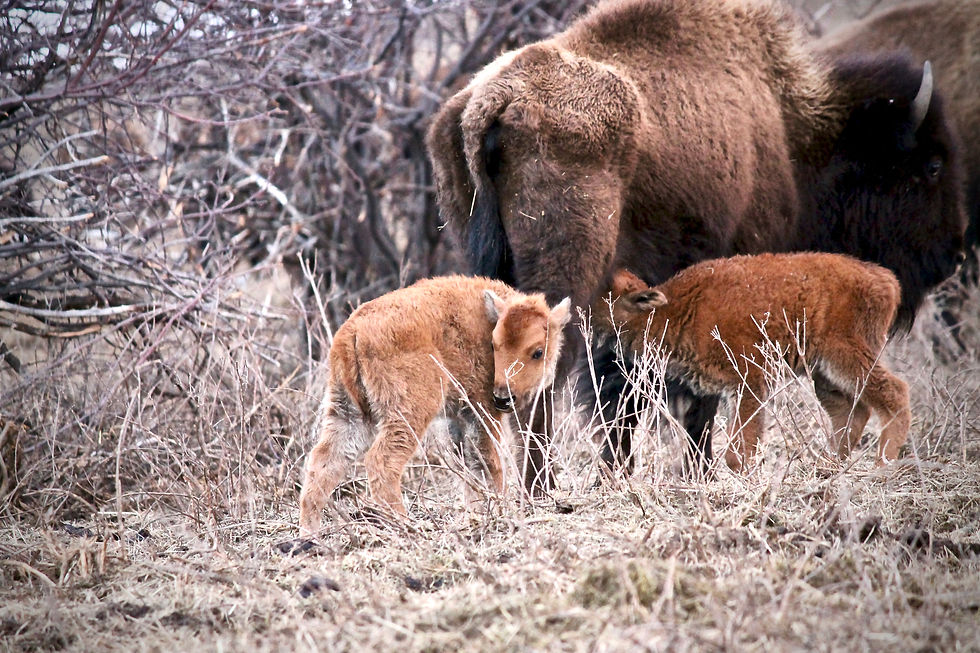
The American Bison
Bison have stood the test of time and man! The Steppe bison, the ancestors of today's bison, roamed the earth and many other large mammals in the Ice Age. These bison roamed over the vast land, including northern Europe, Asia, and North America. Today's bison ancestors were adapted to the cold and much larger than the bison you see today. They had horn spreads reaching 2 meters and were 40% larger than today's bison. The Steppe bison of the Ice Age was the most depicted animal on cave walls from the people in Europe. As time moved on and the earth warmed, the bison evolved. As early as 50,000 years ago, a decline in body size was already underway.
As the Ice Age came to an end and brought way to the warmer Holocene environment, only one of the significant plant-eating species successfully adapted to the change in their environment. The bison! How the bison made the transition is still up for scientific debate. As the ice melted and the sea level rose, the Bering land bridge disappeared, separating the American bison from their Eurasian cousins. There were estimates of 30 million to 70 million head of bison ranging from Alaska to northern Mexico and from the East to the West coast. However, they primarily ran west of the Mississippi on the vast grasslands. There is very little evidence of bison east of the Mississippi before 1700. Evidence states about 94% of meat production were from bison as far down south as Chihuahua, Mexico. It wasn't until the 1850's that the bison were studied for variations in species or subspecies. By 1947 a couple of scientists, Skinner & Kansen, defined one genus, five subgenera, ten species, and four subspecies of bison, totaling 27 species & subspecies. Modern zoologists have changed this view and categorized them as one form of bison that has evolved through time.
Human interactions with bison can be dated to nearly 10,000 years ago in New Mexico. These humans are known as the Paleo Indians. The Paleo Indians were described as big game hunters based on the number of kill sites found. In 1519 the Spanish settlers bringing horses and other domestic livestock changed how people hunted.
The American Bison is a testament to the best and the worst of the west. To the American Indians, these animals provided food, materials for tools, clothing, and many other products. They were not only functional, but they were also spiritual. One cannot stress how important these animals were to the American Indians. The United States government recognized that the fates of the bison & the Native Americans of the plains were closely linked. The government encouraged the slaughter of the bison as a means of controlling, if not eliminating, the Indians. Historians said that every bullet freely given by the government to hunt bison hastened the demise of the Indians.
The early European settlers had a different view of the bison. The bison to them represented a potential for easy wealth. However, many fortune seekers would soon find death rather than success. The bison runners nearly completed their business by driving the bison to near extinction in the 1880s. By 1900 the bison population fell well below 1000 total animals in America.
William Hornaday said it best in his article for the Annual Report of the Smithsonian Institution, published 1889.
"It is hoped that the following historical account of the discovery, partial utilization, and almost complete extermination of the great American bison may serve to cause the public to fully realize the folly of allowing all our most valuable and interesting American mammals to be wantonly destroyed in the same manner. The wild bison is practically gone forever, and in a few more years, when the whitened bones of the last bleaching skeleton shall have been picked up and shipped east for commercial uses, nothing will remain of him save his old, well-worn trails along the watercourses, a few museum specimens and regret of his fate. Suppose his untimely end fails even to appoint a moral that shall benefit the surviving species of mammals that are now being slaughtered in like manner. In that case, it will be sad indeed."
Around this same time, a growing movement would change the course of American history. Many people opposed eradicating a whole species and the remaining Native Americans. Men that participated in the Great Slaughter changed their thinking to save some of the remaining herd. They believed they could make as good of a living selling live animals as they did selling hides. In 1905 the American Bison Society was formed to preserve the bison. Saving the bison could be considered America's first environmental success story. These late efforts to survive the American bison paved the way for modern bison farmers and ranchers.
Today there is an estimated 385,000 bison in North America on private & public lands. The National Bison Association, along with many other ranchers, wants to bring this number up to 1 million by 2025.
Come and see these majestic beats at our Colorado guest ranch! View our National Mammal from an ATV tour, snowmobile tour, or a hayride.






























